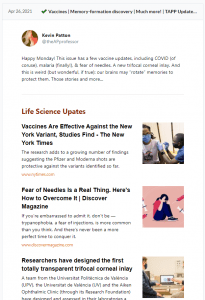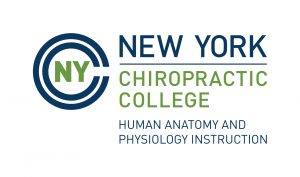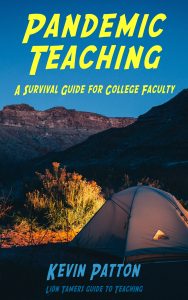Are We Answering Student Questions? | Science Updates
TAPP Radio Episode 92
Episode
Episode | Quick Take
Episode 92 is all about how we can use customer-service concepts in education. Tune in and hear Kevin Patton discuss the importance of being a good listener and empathetic responder. You’ll also hear about new research that shows not all plaques are bad actors when it comes to Alzheimer disease. And finally, find out how to get free almost-daily updates on life science, teaching, and learning!
- 00:00 | Introduction
- 00:53 | New Discovery about Plaque
- 08:33 | Sponsored by AAA
- 09:51 | New TAPP Science & Education Updates
- 15:23 | Sponsored by HAPI
- 16:45 | Are We Answering Student Questions?
- 30:52| Sponsored by HAPS
- 31:40 | Power Skills for Answering Students
- 40:19 | Staying Connected
Episode | Listen Now
Episode | Show Notes
The most basic of all human needs is the need to understand and be understood. The best way to understand people is to listen to them. (Ralph Nichols)
New Discovery about Plaque
7.5 minutes
In teaching A&P, it’s not our objective to dive too deeply into pathophysiology. But we do use it as a tool to help students understand and apply concepts of “normal” structure and function. A new discovery about plaque’s role in Alzheimer disease—or perhaps what is NOT its role—is a story that at once helps students make clinical applications, lets students know more about the vital functions of glial cells, and gives a glimpse of contemporary scientific discovery.
- Plaque Protect: Study Makes Surprising Finding About Alzheimer’s Hallmark (summary article) my-ap.us/3aJFzCy
- In surprising twist, some Alzheimer’s plaques may be protective, not destructive (announcement from Salk Institute) my-ap.us/2S9BvW5
- Microglia use TAM receptors to detect and engulf amyloid β plaques (research article from Nature Immunology) my-ap.us/3eBEf5S
- Image: dense-core amyloid-beta plaque (red) surrounded by microglia (white) [Credit: Salk Institute] my-ap.us/3gFlp0l
Sponsored by AAA
1.5 minute
A searchable transcript for this episode, as well as the captioned audiogram of this episode, are sponsored by the American Association for Anatomy (AAA) at anatomy.org.
Don’t forget—HAPS members get a deep discount on AAA membership!
New TAPP Science & Education Update
5.5 minutes
You may (or may not) remember that Nuzzel newsletter I’ve had going a couple of years. It was an almost-daily curated list of headlines of interest to anatomy and physiology faculty (and, I’ve discovered, some random non-A&P folks who just like the content). Well, Nuzzel is suddenly shutting down it’s newsletter function and so I’ve switched to Revue by Twitter. Here’s how to subscribe (it’s free) if you’re not already subscribed:
- The A&P Professor Science & Education Updates theAPprofessor.org/updates
Sponsored by HAPI Online Graduate Program
1.5 minute
The Master of Science in Human Anatomy & Physiology Instruction—the MS-HAPI—is a graduate program for A&P teachers, especially for those who already have a graduate/professional degree. A combination of science courses (enough to qualify you to teach at the college level) and courses in contemporary instructional practice, this program helps you be your best in both on-campus and remote teaching. Kevin Patton is a faculty member in this program. Check it out!
Are We Answering Student Questions?
14 minutes
No, really. Am I really answering what each student wants to know? Or am I simply reacting to key words or phrases without really listening to the specifics of each student question. This segment asks us to consider using some customer-service (gasp!) techniques to make sure we’re not leaving our students alone and frustrated.
- Some previous episodes that touch on the customer-service model and student questions
- Information on TextExpander—a tool for quickly inserting saved snippets of text (I am an affiliate)
- The Case for Case Studies | Episode 52 (has a segment discussing TextExpander
- theAPprofessor.org/textexpander
Sponsored by HAPS
1 minute
The Human Anatomy & Physiology Society (HAPS) is a sponsor of this podcast. You can help appreciate their support by clicking the link below and checking out the many resources and benefits found there. Watch for virtual town hall meetings and upcoming regional meetings!
Power Skill for Answering Students
8.5 minutes
Starting with some “power phrases” from a recent article, we explore some words and phrases to use when answering student questions.
- These 7 phrases can help you sound more powerful at work (article mentioned in this segment) my-ap.us/3eykP1N
Need help accessing resources locked behind a paywall?
Check out this advice from Episode 32 to get what you need!
Episode | Captioned Audiogram
Episode | Transcript
The A&P Professor podcast (TAPP radio) episodes are made for listening, not reading. This transcript is provided for your convenience, but hey, it’s just not possible to capture the emphasis and dramatic delivery of the audio version. Or the cool theme music. Or laughs and snorts. And because it’s generated by a combo of machine and human transcription, it may not be exactly right. So I strongly recommend listening by clicking the audio player provided.
 This searchable transcript is supported by the
This searchable transcript is supported by the
American Association for Anatomy.
I'm a member—maybe you should be one, too!
Introduction
Kevin Patton (00:01):
The late Ralph Nichols, who established the scholarly field of listening, once wrote: “The most basic of all human needs is the need to understand and be understood. The best way to understand people is to listen to them.”
Aileen (00:22):
Welcome to The A&P Professor, a few minutes to focus on teaching Human Anatomy and Physiology with a veteran educator and teaching mentor, your host, Kevin Patton.
Kevin Patton (00:35):
In this episode, I talk about listening and responding in ways that helps students. There’s a new discovery regarding plaques in the brain, and a new way to get A&P science and teaching updates.
New Discovery about Plaque
Kevin Patton (00:55):
Science has known for a long time that Alzheimer’s disease or AD for short is characterized by the build-up of amyloid beta plaques in the brain, and science has also seen a lot of drugs being developed to target these plaques. But you know what, those drugs have largely failed in clinical trials. Well, there’s been a new discovery at the Salk Institute that may explain that those plaques, at least not all of those plaques are bad actors in AD. So maybe some of those anti-plaque therapies are doing more harm than good. Now, there are a bunch of different kinds of plaque, but the two main kinds are characterized as being either diffuse or as dense-core plaques. Diffuse plaques, as their name suggests, are loosely organized, kind of wispy clouds when you see an image of then. Dense-core plaques have, well, as their name implies, a tight compact center surrounded by a somewhat less dense halo.
Kevin Patton (02:11):
Now, many scientists have thought that both types of plaque form spontaneously from excess production of a precursor molecule called amyloid precursor protein or APP for short. But, according to a new study published just a few weeks ago, it’s actually microglia that form dense-core plaques from the diffuse amyloid beta fibrils as part of the microglia duty of cellular clean-up….
Now, this discovery builds on an earlier discovery in 2016, by the same lab, which found that when a brain cell dies, a fatty molecule flips from the inside to the outside of the cell surface. That molecule signals, “Hey there, hey there, I’m dead. Eat me.” In microglia, by way of surface proteins called TAM receptors … that’s capital T, capital A, capital M … so the microglia have these TAM receptors that allow them to engulf or eat the dead cell. Without TAM receptors, microglia cannot connect to dead cells and, therefore, can’t gobble them up.
Kevin Patton (03:44):
The new discovery shows that it’s not only dead cells that exhibit the eat me signal, so do the amyloid plaques prevalent in Alzheimer’s disease. The researchers demonstrated experimentally, for the first time, that microglia with TAM receptors eat amyloid plaques by way of the eat me signal. Then they engineered some mice to lack those TAM receptors, and you know what, the microglia were not able to gobble up the plaque. Digging deeper, they trace the dense-core plaques using alive imaging. You know what? They discovered that after a microglia cell eats the diffuse plaque, it transfers all of that nasty amyloid beta stuff they just gobbled up into a little acidic compartment that like chemically smashes it up like a chemical version of a trash compactor in forms of tighter mass. When that mess, or I mean, mass … let’s just call it a tight messy mass … gets transferred to a dense-core plaque.
Kevin Patton (05:06):
The researchers are suggesting that this is a beneficial mechanism, organizing diffused plaque into dense-core plaque and thereby clearing the intercellular environment of debris. They say that their research seem to show that when there are fewer dense-core plaques, there seem to be more detrimental effects. When there are less dense plaques, there’s more damage to neurons. That is, the dense plaques seem to be, well, kind of benign and not just in the sense that they don’t cause harm, but really, maybe in the sense that they might reduce harm. So those dense-core plaques, they’re not bad actors, maybe they’re good actors. Maybe they’re the heroes of the story. Now, one of the next steps that the researchers are going to take is to do some cognitive studies to see if increasing the activity of those TAM receptors and microglia might reduce the effects of AD.
Kevin Patton (06:25):
Now, they’re not saying that amyloid beta is a good thing. It’s not. It’s bad. They’re suggesting that when looking for a cure for Alzheimer’s disease, maybe we should stop trying to focus on breaking up dense-core plaques because maybe they are doing a helpful job and maybe we should instead start looking at treatments that either reduce the production of amyloid beta in the first place, or therapies that promote the transport of amyloid beta out of the brain all together.
Kevin Patton (06:59):
Now, like many of these discoveries or updates I share, this one is not a core principle of A&P and I’m not suggesting that we need to add this as required content in our course. Nope. But I do think that it’s an interesting little story of what scientists are up to these days. Trying to see how microglia do their jobs and how that can help us figure out therapies for a really devastating disease so that, well, when students think, “Why do we have to learn about glia? Why? Glial cells aren’t really doing anything very important and that’s just too much detail. Let’s get to the parts that we really need to know.”
Kevin Patton (07:51):
Well, maybe if they hear stories like this, they might stop themselves and say, “Oh, what a brilliant A&P professor I have. They know just what I need. I need to know about glia,” and they’re telling me just what I need to understand. It really makes sense of the structure and function of the body. But, well, okay, if they fail to draw that conclusion and maybe they ask why they need to know about glial cells anyway, well, you can pull out the story and say, “There, that’s why, because it could someday save your life.”
Sponsored by AAA
Kevin Patton (08:34):
If you’re a regular listener to this podcast, you already know that AAA, the American Association for Anatomy, sponsors the searchable transcript and the captioned audiogram of each episode of this podcast. If you’re not a regular listener or you just don’t remember, I’m telling you now, because that’s a big deal. We all know that universal design helps everyone. Using a learning resource, such as our podcast, and we know that making transcripts and captions available for audio content is part of the universal design approach. But getting a transcripts that can handle the tough terminology we use sometimes, like, oh, I don’t know, carbaminohemoglobin. You knew I’d work that in somehow, right? Anyway, that kind of terminology means it takes extra work to get a good transcript, and AAA is there for you, making sure that you have that. You want to know more about AAA, just go to Anatomy.org.
New TAPP Science & Education Updates
Kevin Patton (09:51):
For the past few years, I’ve been running an almost daily email newsletter using a service called Nuzzel that allowed me to scan the hot stories of the day and pull out those that would be of interest to people who are teaching Anatomy & Physiology. So those would be science updates, like the one that we just heard about with the plaque and that. So when that news came out, I put that into the update newsletter. There’s also updates on things happening in the world of teaching and learning, and occasionally some announcements in the word of the A&P professor. So new resources available on the website, or when a new episode of this podcast comes out, or things like that.
Kevin Patton (10:41):
It turns out that a couple of weeks ago, Nuzzel decided that they were going to stop offering that newsletter service. So it still helps me scan the hot news of the day, I have other ways of doing that as well, but it stopped allowing me to send out that update newsletter and they didn’t give me much time, so isn’t that the way it always goes? You come to rely on some technology and then somebody comes to you and says, “Hey, guess what, we’re shutting that down. Here’s a list of a few things that might be kind of like that, why don’t you try those?” So Nuzzel did that, and so, yeah, okay, I’m used to having to scramble like that. So it stressed me a little bit, but not as much as it could.
Kevin Patton (11:30):
So, as usual, the list of alternatives, none of them did what Nuzzel did. It was a unique thing. I mean that’s why I was using it. But I did find one that’s pretty good and it had some other features that Nuzzel didn’t have. So in some ways it’s better; in some ways I don’t like it as much, but it’s one of those things that I think I’m going to be able to grow into and hopefully you’ll grow into it with me. So now, I no longer call it the Nuzzel newsletter. Now we’re just calling it The A&P Professor Update or TAPP Update, for short. Remember, TAPP stands for The A&P Professor.
Kevin Patton (12:08):
So our TAPP Updates, I’m going to go instead of trying to do it five days a week, I’m going to aim for three days a week. So every Monday, Wednesday, and Friday, we’ll see how that goes. It’s still almost daily if I do that, but that’ll allow me some a little bit of extra time to get used to how this process, this workflow is going to work out for me and for you. one of the things it allows me to do is group them into “Here are the Life Science updates, and here are the Teaching and Learning updates, and here are the TAPP updates.” Maybe that’ll help you as you scan through it. If you’re already subscribed to the Nuzzel newsletter, you’ve already probably seen this news because, I don’t know, we’re up to probably by the time you hear this like 7, 8, 9, 10 issues already so you’re already getting that.
Kevin Patton (13:02):
So all my subscribers who had opted in to getting the Nuzzel newsletter just got shifted over and it was hopefully pretty seamless. However, if you didn’t get my Nuzzel newsletter, maybe you never heard about it before. Well, now it’s your chance to sign up for it. It’s free. There’s an Unsubscribe button at the bottom of every issues, so if you don’t like it, then just unsubscribe. And please do unsubscribe. Don’t put it in the junk mail folder and don’t just keep deleting it because something I found out is that internet service providers, the people that provide the wires that bring all these stuff to you, they monitor that. If they see that my newsletter is getting put in the junk folder, then they will shut out my newsletter from everybody who uses that internet service provider. So people who actually want to get it are no longer going to be able to get it.
Kevin Patton (14:00):
So don’t ever, with any newsletter you get, if you don’t want it anymore, please unsubscribe. Don’t just put it in the junk mail folders. So there’s another lesson for today. At today’s episode, we learned that we should never put things we actually subscribe to into the junk folder. We should unsubscribe from them. But, anyway, you have that option, unsubscribe anytime, so why not try it and see if it’s helpful to you? Since it’s only coming out three days a week, maybe you won’t be tempted to put it in the junk folder when you find that you’re not able to keep up with it. If you have any suggestions for things I should put in there, just send them to me: podcast@theAPprofessor.org, and then that’ll give me a tip as to some hot update that we all need to know about and I can put that in the newsletter. If you do that, I’ll give you credit in the newsletter as well.
Kevin Patton (14:55):
So the question is how do I subscribe? Well, that’s really easy. Just go to theAPprofessor.org/updates, and that’s plural, updates, and it’s all small case. So theAPprofessor.org/updates and you’ll get my almost daily newsletter that we’re calling The A&P Professor Science and Education Updates.
Sponsored by HAPI
Kevin Patton (15:24):
The free distribution of this podcast is sponsored by the Master of Science in Human Anatomy & Physiology Instruction, the HAPI degree. As I’ve mentioned frequently, I’m on the faculty of this program, and I’ve been recently corresponding with one of our graduates warning me of reference calls that I’m going to be getting from colleges where he’s a finalist for A&P teaching positions one after another. He was apologetic for this disruption to our lives, but what he doesn’t know is that this happens all the time. Well, not all the time; only during hiring season, but it does happen and, no, it’s not a bother. We, faculty in the HAPI program, love talking about all the great skills and insights and personal growths that our graduates have done during their time with us. Are you looking to power up your game in teaching A&P? Maybe it’s time for you to check out this online graduate program at nycc.edu/hapi. That’s H-A-P-I, or click the link in the show notes or episode page.
Are We Answering Student Questions?
Kevin Patton (16:45):
As I’ve mentioned on previous episodes, I think it’s helpful for me as a teacher to answer student questions as if I’m a customer service representative.
Crowd (16:56):
Students are not customers.
Crowd (16:57):
Students are not customers.
Crowd (16:57):
You didn’t.
Kevin Patton (17:00):
Okay, just hold on there. I know, I know. It’s a sore point with most educators when I compare students to customers. But they are customers in a way.
Crowd (17:12):
No.
Crowd (17:13):
Students are not customers.
Crowd (17:13):
No. No, they are not.
Crowd (17:13):
They’re not.
Kevin Patton (17:16):
Oh, just stop it. I don’t mean students are customers in every way or that a college or university is just like a big box store. No, no, no. No. That’s four noes. But for answering student questions, I do think there is a lot to learn from how customer service agents do their jobs. That is, when they actually do their jobs and do it well and make me as the customer feel satisfied, and maybe even feel good about them and about myself when I interact with them. Well, I recently had a whole week of experiences where help center agents did not listen to my issue. They must have just heard keywords or key phrases. Maybe these are like commonly encountered issues that they hear a lot and they gave me an answer that only peripherally related to the issue I needed help with. I even had one of those exchanges where they didn’t address my issue at all and then blew me off by telling me that if it happens again, let them know and they’ll look into it. I’m like, “What? Why not solve it now and let’s not wait for it to happen again. I don’t want it to happen again and that’s why I’m contacting you.”
Kevin Patton (18:58):
This wasn’t what happened, but here’s an example of what I mean by not answering the question. Let’s imagine I ordered a pair of brown shoes but I received black shoes instead. So I contact the customer service agent who responds that …
Customer Service Agent (19:19):
All the shoes come with black shoelaces, even brown shoes.
Kevin Patton (19:23):
And then I responded, “It’s not about the laces; it’s the shoe color,” and they respond that.
Customer Service Agent (19:33):
The laces are not shipped on the shoes, but are in a separate package inside the shoebox.
Kevin Patton (19:39):
No. That’s not the concern.
Customer Service Agent (19:43):
Have you looked inside the shoes for the packet of shoelaces?
Kevin Patton (19:47):
No, I have shoelaces.
Customer Service Agent (19:50):
As a courtesy, I can mail you a packet of shoelaces but we only have black shoelaces.
Kevin Patton (19:56):
No. I don’t need shoelaces. I need brown shoes.
Customer Service Agent (20:03):
Oh, okay. That style of shoe does come in brown. Would you like to order a pair now?
Kevin Patton (20:08):
Ah! See, that’s what I’m talking about. Now, I do understand that a lot of these agents are working from home these days and they might be trying to keep their toddler from swallowing a button, or wiping out some spilt milk, or trying to get a cork out of a wine bottle, all kinds of things that might be fighting for their attention while they’re talking to me. But they’re still not really listening and not really answering my concern. So as I sat pondering this phenomenon, while I waited for a service agent to tweet me back with what turned out to be another hit and a miss, they were still not addressing my issue and I thought to myself, “Do I do this to my students?” This isn’t a new thing for me to be pondering. I’ve pondered this before, and I repeatedly promised myself to make sure that my students don’t experience this in my course.
Kevin Patton (21:19):
But I need reminding of these things, and these unhelpful help center experiences do remind me of that. So what kinds of things can I do to make sure that my students don’t get a crappy help experience with me? Well, the first thing I do, and I’ve said this in previous episodes, is that I try to remember to intentionally smile first before I respond. Even if it’s just answering an email or a direct message in the learning management system, and there’s nobody around. I still try to smile because that does something to the way I’m thinking. It does something to my attitude. This helps me set the tone that I want to project and it calms me down a little bit.
Kevin Patton (22:12):
Actually, this so-called first step often comes after I’ve given things a few minutes to sort themselves out in my head. I don’t usually just immediately respond. I stop and think it through. What are they really asking? Why is that upsetting me if they’re asking me this, and just sort through all these stuff. That’s especially useful when something in the question has set me off a bit. For example, if the student question is unnecessarily angry in tone, or it involves something that I’ve explained a million or maybe a bajillion times before. Or the classic, which is sending the question to my dean because they didn’t get an answer on Saturday night when they sent it. I just got one of those.
Kevin Patton (23:05):
Then my second step, or maybe this is my third step. I lost count already and we’re only in the beginning of my list. So second or third step, and you’ve heard this from me before as well. I start with some version of the statement, “That must be very frustrating for you,” which sends the signal that I am trying to empathize with the student. Tagged on to that is some variation of “But we’re going to get this sorted out,” which signals that I’m on their side and I’m willing to do what it takes to get to a solution even if it’s not the solution. They envision, but I don’t tell them that part. This “we’re going to get this sorted out statement” also puts a positive spin on it. That things are going to turn out okay or at least relatively okay, so we’re good to go. Let’s just stick with this. Let’s work it out.
Kevin Patton (24:11):
Then, and this is the part I have to really work at. I have to listen to their question or their complaints or concern or whatever it is, and I mean truly listen. Are they just venting? In which case, doubling down on that empathy thing is usually what solves the matter for them. Just let them vent and empathize with them and they start cooling off, and it starts being okay. That’s all they needed from me, really. Honestly, if it’s not simply a matter of venting frustration, it’s almost always one of those handful of questions that are commonly asked. For those, I may already have a very complete and kind response in the form of a snippet already stored in my TextExpander, which has a library of snippets that I can just plug right in. I’ll have a link to TextExpander in the show notes and episode page. I talked about that in previous episodes, but it’s basically a snippet library where you just type in an abbreviation and that text just shows up in your email response or direct message or whatever it is you’re using. So I just make some adjustments and personalizations to that snippet and, well, everybody’s happy, the question gets answered, and the student feels like I’ve really engaged with them one on one, which I have, and that’s it. End of story. Job well done. Tap myself on the back.
Kevin Patton (25:52):
But here’s that hard part. I need to take that extra step, that intentional step of circling back to make sure that I’m actually addressing the specific problem that the student is bringing to me. One way I can do that is to re-read the message from the student. Before I send out any answer, snippet or not, personalized or not, if I go back and re-read that message from the student, I want to see if I’ve really understood their point, if I really understood what they’re asking. If I don’t understand or I’m not sure that I understand, one option is to ask for clarification. That’s not usually my first choice, and I only do that when I really have no clue whatsoever.
Kevin Patton (26:46):
Students want answers quickly, and me coming back for a restatement of what they thought was clear the first time isn’t always the best strategy, I’ve discovered. What I usually do is take a stab at answering what I think the issue is. But carefully preceding my answer with a statement that I’m not sure if I really understood what’s being asked here. But if it’s this, here’s the solution, and then I follow that up with, again, stating that I may not really answer the main question, so please ask me again to clarify what they really need from me.
Kevin Patton (27:29):
Now, if I’m answering a live question; that is, face-to-face, in-person question, then that old tried and true strategy of restating the question before answering it usually works. Something like, “Is that what you want to know, the date of our next exam?” Or, perhaps, “Are you asking what the functions of the hepatocytes are, or are you asking where they’re located?” as an example. Now, using my lion taming skills, I’ll read the signs in the situation to gauge the mood. Ears back against the head, tail swishing, growling, that sort of thing. But, if things are cool, I might answer that question about the exam date with, “Oh, did you check the syllabus or the course calendar?” Just to remind them that they could have gotten their answer much more quickly than by asking me, and that other question about the hepatocytes, I almost always answer that sort of question with something like, “What do you think the functions of the hepatocytes are?” When they say, “I don’t know,” then I’ll ask for a guess. If they have no guess, well, then, I start asking some leading questions. If all else fails, I’ll open the book and ask them to find the section on hepatocytes in their notebook or in the textbook, and then we can go through it together and try to find that answer.
Kevin Patton (29:14):
I do it that way because my role isn’t to be the answer man. My role is to help you learn how to find answers on your own person. So that’s what I do. I walk them through that. If they get used to the fact that I’m not just going to give them the answer, that I’m going to ask them to work for it and show them how to find it. Because a lot of times students really don’t know what the next step is, especially those that aren’t necessarily neurologically typical. May not know how to do that next step, and the more practice we do at that, the more they learn how to do that.
Kevin Patton (29:54):
So, yeah, this last week, I have reminded myself to make sure that I’m listening. I mean really listening to my students. This is what I have to be especially careful about. That I’m not just reacting to keywords or phrases, and answering what I’m used to answering instead of what I’m actually being asked in that moment. Because I find that it’s when students see that I’m truly listening and that I really want to connect with them and I really want to help them that the magic happens. You know what? I’m hoping that if I model good listening skills, my students will be better listeners themselves when that day comes for them to be listening to questions from their patients or clients who come to them as health professionals.
Sponsored by HAPS
Kevin Patton (30:52):
You may already know that marketing support for this podcast is provided by HAPS, the Human Anatomy and Physiology Society, promoting excellence in the teaching of Human Anatomy & Physiology for over 30 years. What you may not know is that all the cool things HAPS offer A&P instructors. Even though I’ve been a member since the beginning of HAPS, even I can’t keep up with all the resources and activities that HAPS offers. You want to get a taste of them? Go visit HAPS at theAPprofessor.org/haps. That’s H-A-P-S.
Power Skills for Answering Students
Kevin Patton (31:40):
In a previous segment, I threw out a few tips about answering student questions in the context of really listening to make sure that we’re answering the question asked. That is, not simply responding to a keyword or phrase that we heard without really stopping to see if what we assume they’re going to ask us is what the student is actually asking us. As I was thinking about this topic a couple of weeks ago, I happen to run into a brief article by Gwen Moran about phrases that we can use at work to sound more powerful. But really, it turned out to be a compilation of communication skills that can really work in situations of conversing with students. I’m not sure how powerful they’ll make me sound to my peers, but I really do think that they’ll help students realize that I’m on their side.
Kevin Patton (32:39):
As usual with these sorts or articles, some of the skills or tips I’d heard before, and some of them I have actually been using in one form or another. But some of them open my eyes to how I can better communicate with my students. One of the things that I do that this article suggests that I should not do is say I’m sorry too much. Yup, I do that. Sorry. Well, they’re not suggesting that we never say sorry. We need to stop using that as a throwaway phrase or a verbal habit. They suggest something like, “Thanks for your patience, which recognizes the person’s feelings of being put out,” and it puts a positive spin on it, I think. I’m thinking it might also plant the idea in the other person’s mind that they’ll always be recognized and appreciated for not losing their cool and not getting overly frustrated. I don’t know. I like being thanked for my patience when I’m simmering inside. It’s like saying, “You have a right to get huffy with me, and I’m so glad that you’re working to hold that back and not getting huffy with me.”
Kevin Patton (34:08):
Another suggestion is to stop responding to students by starting off with the word but. Why not? Because it sends the signal that I’m dismissing everything that student just said to me. Even if don’t intend to do that, I may send that signal anyway when I start by saying, “But …” But instead starting off with the phrase “and” when responding to a student. I’m not sending a signal of rebuttal, but instead just picking up where they left off. They’re less likely to think that I’ve just dissed them in some way that I didn’t intend to. But even if I am going to turn things around in a different direction or if I don’t really agree with what they’ve just said, I’ve not started out by shutting them down so that they can’t or won’t really hear what I have to say.
Kevin Patton (35:14):
Another phrase that doesn’t work so great is “I can’t.” Of course, there are all kinds of things our student may want us to do that we simply can’t accommodate. At least not in the way it’s asked. Like, canceling the final exam or something. If I start my response with I can’t, then the student is not going to listen closely to my rationale if I even offer one. What I can do is, well, what I just now did. That is, start off with something like, “Here’s what I can do …” Because there’s almost always something I can do related to the student’s request. Why did they want to cancel the final? Because they’re not prepared? What can I do to give you some guidance on how to prepare? Even if you don’t have much time, I can help you prepare. Is it because they have test anxiety? What I can do to help you with that and give you maybe some tips on managing test anxiety? Is it because of some bad thing happening in their lives? Maybe what I can do is offer them a different exam time or different exam format or some other kind of assessment, or maybe offer them or help them find some kind of assistance or maybe find some way to be flexible in the situation.
Kevin Patton (36:48):
One of my favorite phrases to use in responding to students is to tell them that, “We’ll solve this.” It’s saying that it’s not completely up to you, the student, and it’s not completely up to me, the teacher, by saying, “We can solve this,” or “Let’s solve this.” What I’m doing is I’m committing to working with them. Now, again, the solution may not be what the student has in mind. But there’s always some kind of a solution to be gotten to, I think, at least, almost always.
Kevin Patton (37:22):
That article I mentioned also suggests avoiding telling people to calm down when they’re upset about something. That not only doesn’t work. Have you ever said that to somebody who is losing their cool and you say, “Calm down”? What does that do? It usually gets them more upset, which makes me think of my days as an apprentice lion tamer. The thing about lions is that when thinks are not going well for them, they get very upset very quickly. I mean really, really blustery and loud and dangerous. Giant jaws with giant teeth and massive paws with massive claws that are razor sharp. Lions re way more reactive in this way than other big cats or other wild animals or even people that get set off easily. Lions are just way, way more than any of that.
Kevin Patton (38:32):
I learned that the last thing I want to do if I value my life and limb, which I do, is to push back. That’s the last thing I want to do is to push back. That works well with students whether they’re upset, is very dramatic. Believe me, I’ll never approach the drama of a lion who’s upset. But it can get pretty dramatic. But it doesn’t matter if they’re upset and is dramatic or it’s very quiet. It still works. I avoid immediately pushing back. I don’t run and hide either. By the way, here’s a pro tip. If you eve encounter a lion, don’t run. They’ll chase you. That’s an automatic response for a lion is to chase after you and they’ll hurt you. They might even eat you. So don’t run. But don’t threaten them either. Stand your ground. Yeah, I know, that’s easier to say, but it can save your life. It actually has saved my life.
Kevin Patton (39:41):
You know what? It works with students, too. If we can stay calm and not push back, but not run away, we may be able to solve the problem without too much trouble. If we can remain calm, it’s more likely that the student will start to feel better, then we can deploy our power phrases, which are really just ways of telling them that we truly want to help and that we will truly get them through this. More often than not, things will work out.
Staying Connected
Kevin Patton (40:19):
Well, in this episode, we learned that plaque in the brains of those with Alzheimer’s probably isn’t what we thought it was. And we got an update on my almost daily update newsletter, and I hope I got us all thinking more about how we communicate with students when they have questions. That’s a topic that makes for a great conversation with your A&P teaching colleagues. Why not share this episode and get that chat going? Simply go to theAPprofessor.org/refer to get a personalized share link that will not only get your friend all set up with this episode, it’ll also get you on your way to earning a cash reward. Don’t forget the links that I have for you in the show notes at the episode page at theAPprofessor.org/92, where you can explore any ideas mentioned in this podcast. While you’re there, you can claim your digital credential for listening to this episode. I’m always glad to hear your comments and questions at the podcast hotline. That’s 1-833-LION-DEN, or 1-833-546-6336, or send a recording or written message to podcast@theAPprofessor.org.
Kevin Patton (41:53):
You’ve invited to join my private A&P teaching community way off the social platforms where you can have some of those conversations with A&P colleagues that I just mentioned. Just go to theAPprofessor.org/community. Before I forget, what’s coming up on the horizon? Well, our friend, Krista Rompolski, will be here in an upcoming episode with a powerful article about weight bias and what our part is in the development of weight bias among health professionals. You don’t want to be left out of that. So make sure that you’re following this podcast wherever you listen to audio, and I’ll see you down the road.
Aileen (42:43):
The A&P Professor is hosted by Dr. Kevin Patton, an award-winning professor and textbook author in Human Anatomy and Physiology.
Kevin Patton (42:56):
No animals were harmed during the making of this podcast.
This podcast is sponsored by the
Human Anatomy & Physiology Society 
This podcast is sponsored by the
Master of Science in
Human Anatomy & Physiology Instruction 
Transcripts & captions supported by
The American Association for Anatomy. 

Stay Connected
The easiest way to keep up with new episodes is, um, wherever you already listen to audio!
Click here to be notified by email when new episodes become available (make sure The A&P Professor option is checked).
Call in
Record your question or share an idea and I may use it in a future podcast!
Toll-free: 1·833·LION·DEN (1·833·546·6336)
Email: podcast@theAPprofessor.org
Share

Kevin's bestselling book!
Available in paperback
Download a digital copy
Please share with your colleagues!
Tools & Resources
TAPP Science & Education Updates (free)
TextExpander (paste snippets)
Krisp Free Noise-Cancelling App
Snagit & Camtasia (media tools)
Rev.com ($10 off transcriptions, captions)
The A&P Professor Logo Items
(Compensation may be received)
🏅 NOTE: TAPP ed badges and certificates can be claimed until the end of 2025. After that, they remain valid, but no additional credentials can be claimed. This results from the free tier of Canvas Credentials shutting down (and lowest paid tier is far, far away from a cost-effective rate for our level of usage). For more information, visit TAPP ed at theAPprofessor.org/education















